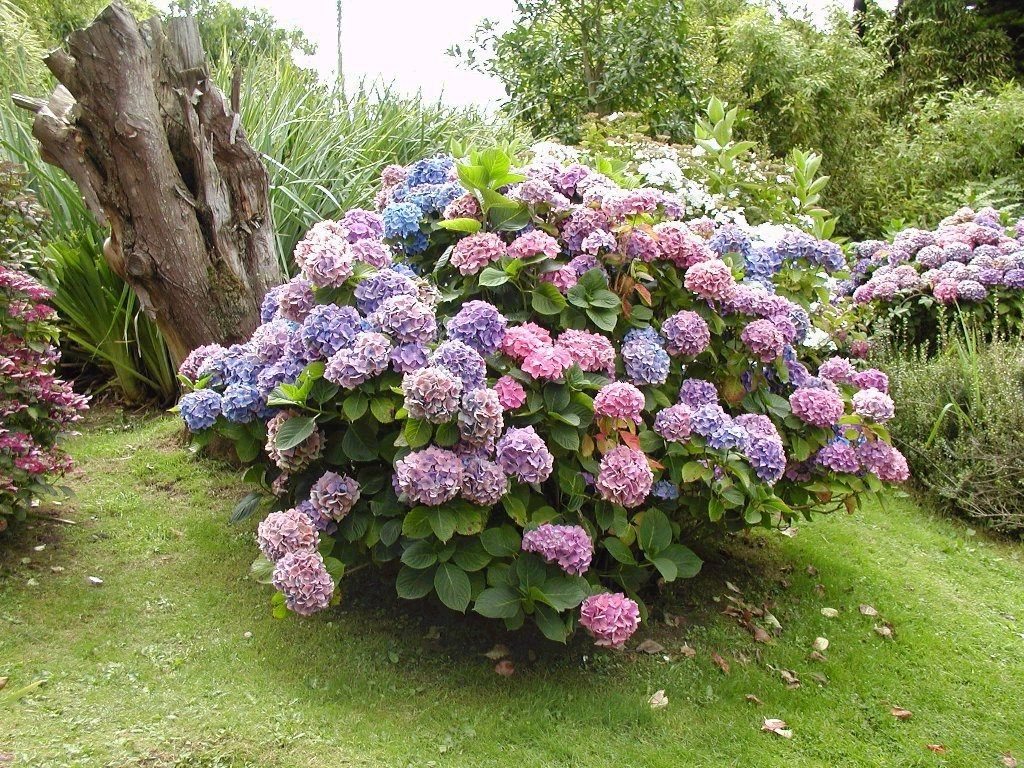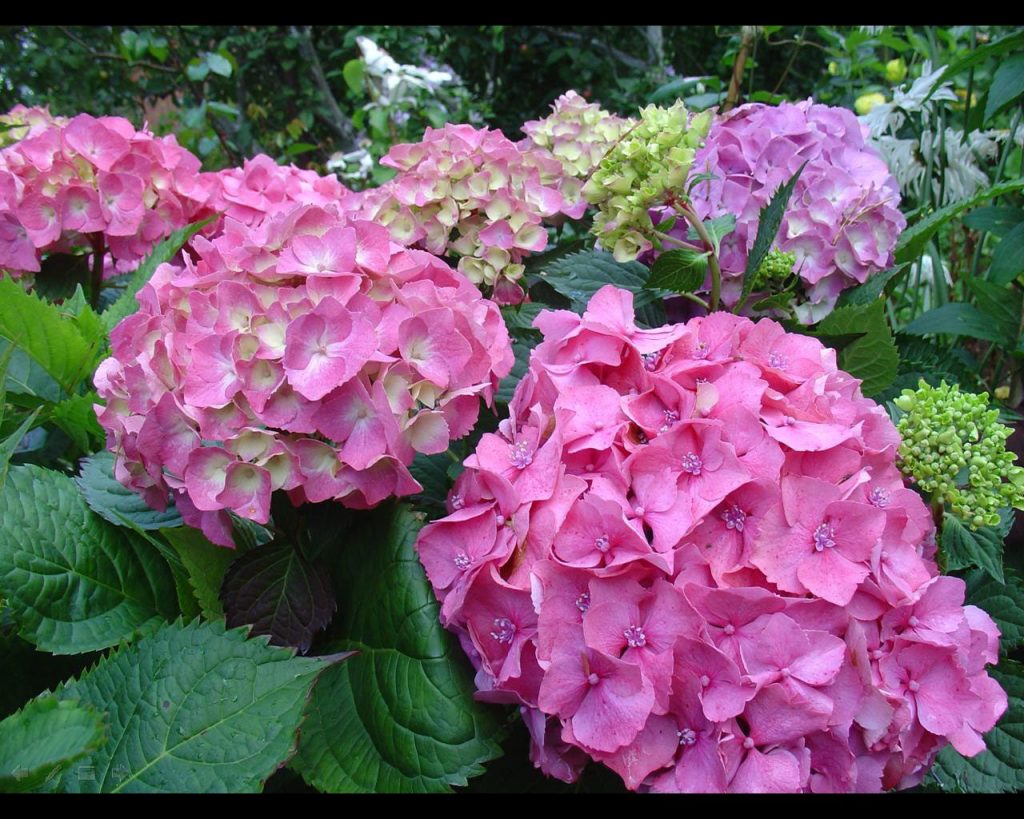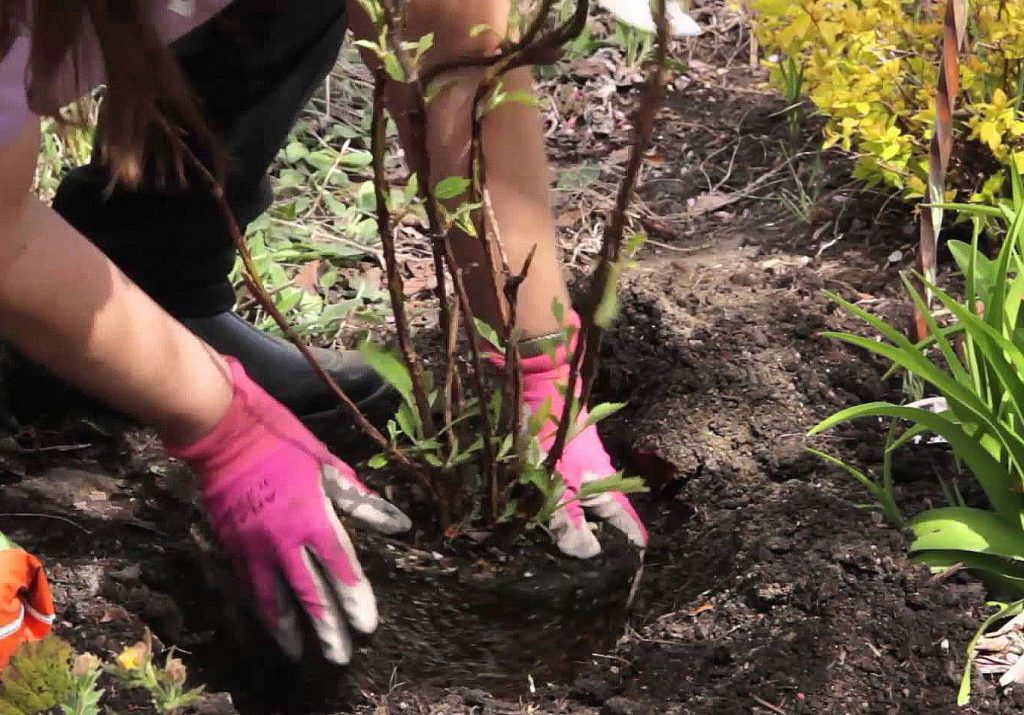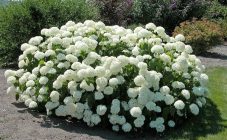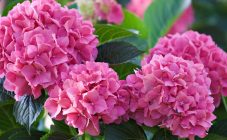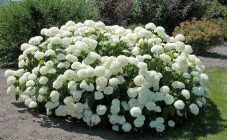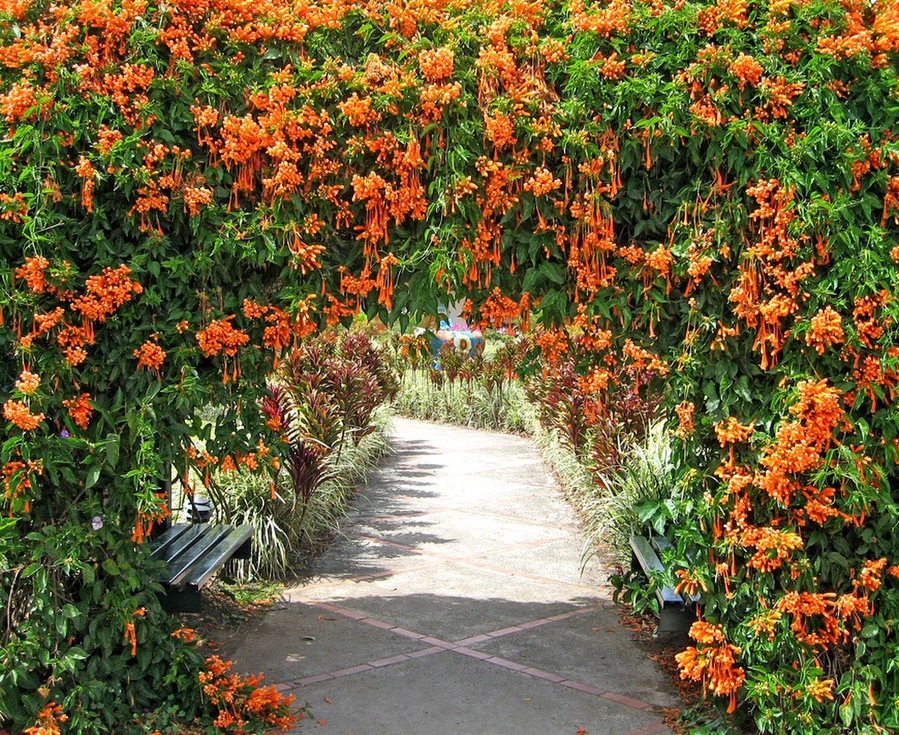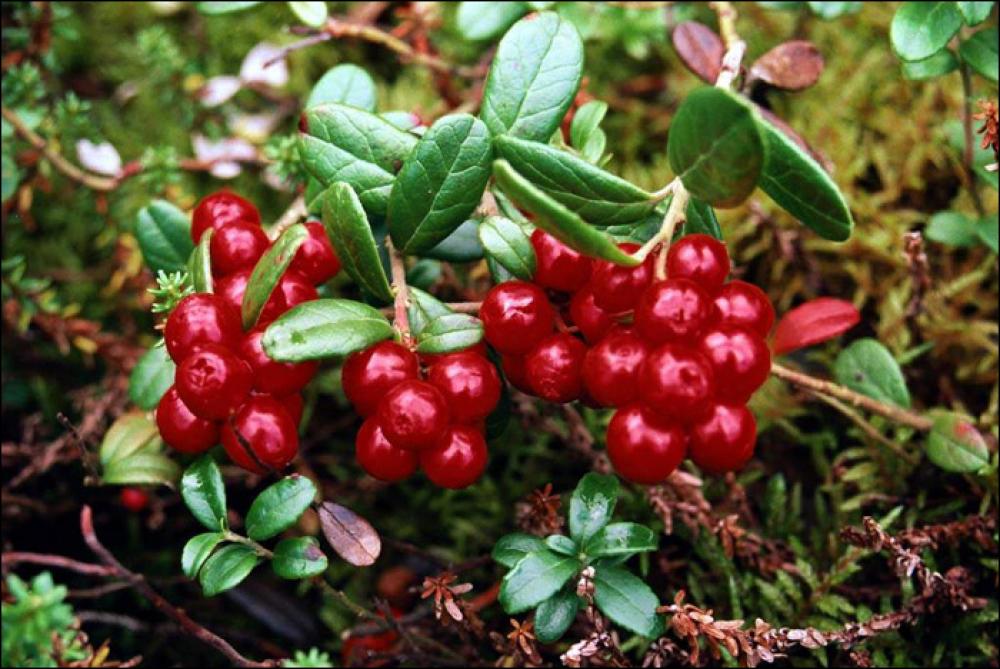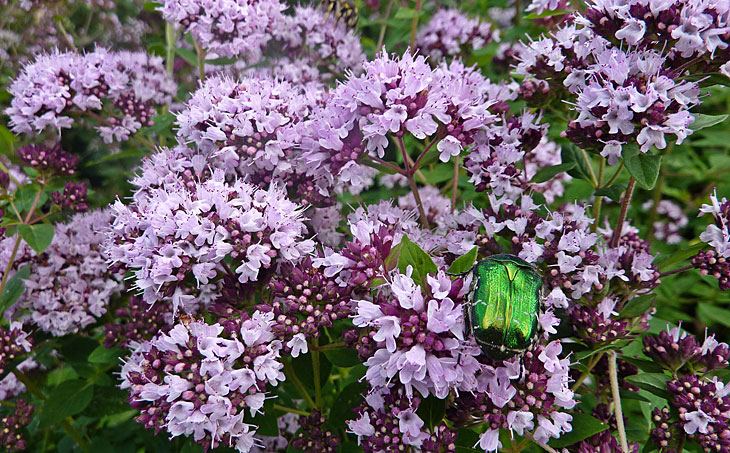Content:
Large-leaved hydrangea differs from other species (paniculate and tree-like) in the variety of shades and the way of flowering. Inflorescences of large-leaved hydrangea can have mono-colors: white, pink, red, blue, lilac, as well as two-color, multi-color, with a color transition. The shades of some varieties can change on an already growing bush, depending on the composition of the soil. On one bush, inflorescences of different shades may be present at once. Varieties with genetic white and red color do not change it.
Garden hydrangea, also called large-leaved and macrophile, got the opportunity to grow in cold climates: from the Moscow region to the Urals and Siberia, about 15 years ago. Before that, this type of hydrangea was available for cultivation only in the southern regions of Russia or at home.
Hydrangeas are inherently not frost-resistant and demanding of soil acidity due to their natural origin. The homeland of the perennial shrub is the Far East, China and Japan. Therefore, in order to grow delightful flowers in regions with a harsh climate, frost-resistant varieties were bred, but still requiring high-quality shelter for the winter.
Large-leaved hydrangea is distinguished by a small, compact bush, generally not reaching more than 1 m in height. The leaf of this type of shrub is large in size: up to 15 cm in length with symmetrical veins and soft serrations along the edge.
The peculiarity of garden hydrangea is that flower buds are laid on the tops of the shoots in the fall of the current year, in contrast to the paniculate and tree-like shrub varieties. Therefore, a large-leaved hydrangea needs high-quality shelter and proper pruning. It is convenient to preserve hydrangea growing in pots by storing it in cellars or other rooms with freezing temperatures for the winter.
Large-leaved hydrangea varieties
Garden hydrangea is divided into separate varieties, some varieties are combined into separate groups or series. Varieties with similar characteristics belong to one group.
As a result of selection, remontant varieties of large-leaved hydrangea were bred, which are capable of blooming both on last year's and the shoots of the current year. Repaired varieties are bred with increased resistance to cold, but they also require mandatory shelter in regions with cold winters. After all, the parameters of frost resistance are applicable to the roots of the plant, and the danger of freezing of the apical flower buds laid before wintering this year remains great. Therefore, when covering the shrub for the winter, they first of all try to preserve the shoots.
The advantage of remontant varieties is that if the shoots freeze, the bush will give new stems during the growing season, while the frozen branches of an ordinary large-leaved hydrangea will no longer bloom. The remontant varieties preserved from frost show continuous, long flowering from mid-summer to late autumn.
Series of frost-resistant hydrangeas:
- Endless Summer means endless summer. A repaired species of large-leaved hydrangea blooming on the shoots of the current and last year.One of the few varieties that begin to bloom from the second year after planting. The color varies depending on the acidity of the soil and is pink and blue. On one bush, inflorescences of various colors may be present. The group includes such varieties as: Twist-and-Shout; Blashing Bride; Original (Baimer); Bloom Star. The rest of the varieties were bred on the basis of Endless Summer.
- Forever & Ever - hydrangea group, which includes varieties: Peppermint; Blue Heaven; Red Sensation; Fantasia; White Ball. The flowers have a variety of colors, terry and dense shields. The bushes are not tall, rounded, with dark leaves.
- You & Me - Japanese selection of hydrangeas. The color series is represented by varieties: Together; Romance; Expression; Forever; Symphony; Eternity; Love. Bushes of the series are compact with large balls of inflorescences, are distinguished by abundant flowering. During prolonged flowering, hydrangea changes its shades of color, differing in pink, purple, cream terry inflorescences.
Selected varieties:
- Aisha are small flowers collected in large caps of inflorescences that resemble lilacs. Aisha is a large-leaved shrub that has a delicate aroma. The bush is densely leafy, reaching 1.5 m in height.
- Salsa is a variety with beautifully fragrant flowers, white or creamy in the middle, turning into a pink border. The variety is bred with increased drought resistance. It is little exposed to diseases and pests. Erect shoots, ornamental shrub reaches about one meter in height.
- Blue popcorn - has large spherical inflorescences, including amazingly shaped flowers that resemble popcorn. The color of the flowers can appear blue, blue and purple, depending on the acidity of the soil. The bush grows one meter in width and height. Resistant to powdery mildew.
Growing features
Of the possible types of hydrangeas that grow in regions with cold winters, more will be needed to care for the large-leaved variety.
For successful flowering, compliance with the rules of agricultural technology is required:
- Illumination is an important condition for growing a perennial. It is the large-leaved hydrangea that is recommended to be grown in partial shade, when illuminated only by the morning or setting sun. Long hot sun rays will oppress the plant, dry out the soil, which will negatively affect growth. Ornamental shrubs are not planted in places with the appearance of drafts or cold winds.
- Soil acidity. Without exception, all types of hydrangeas prefer increased soil acidity, at a level of 5.5 ph. And in the case of large-leaved hydrangea, the acidity of the soil affects the color, especially its blue shades. Acidic soil is created using coniferous substrates. In open ground, the acidity of the soil is maintained constantly, because the soil is washed out by precipitation. The blue color of hydrangea stays well in the right substrate when grown in pots. For hydrangea white garden planting and outdoor care does not require special soil acidification to obtain color. It is good to plant hydrangeas next to heathers, such as: rhododendron, thuja, juniper, due to the similarity of the substrate. But when planting next to tall plants, it should be taken into account that the hydrangea has enough watering and nutrition.
- Watering the moisture-loving hydrangea requires abundant, but not everyday. The recommended watering schedule is twice a week. For irrigation, it is best to use rain water heated in containers. Hard tap water can cause plant chlorosis. Iron chlorosis is manifested by a violation of the formation of chlorophyll, which is responsible for the green color of the leaves, and they begin to turn yellow. Irrigation water can sometimes be acidified using apple cider vinegar or citric acid. In spring, for acidification, colloidal sulfur is scattered under the bush.
- Loosening and mulching is especially important for crops that are sensitive to soil moisture. Mulch is poured in a layer of about 10 cm using peat, coniferous litter or bark. Loosening is carried out superficially, taking into account the occurrence of the root system close to the surface. During loosening, be sure to remove all weeds.
- Ornamental hydrangea is responsive to feeding, which is carried out several times per season. For dressing, liquid fertilizers intended for hydrangeas are used. For blue shades of shrub flowers, special fertilizers are used for this color of hydrangeas, making them according to the instructions on the package. For dressing, manure and ash are not used, lime is not used. Nitrogen-containing fertilizers are not used from the second half of the growing season, so that the plant can better endure wintering.
- The hydrangea shelter should be approached carefully. In the fall, before the onset of frost, the bush is pressed to the ground using arcs, achieving a horizontal position of the branches. An adult bush is difficult at first to be pressed, then it can be divided into two parts, which are pressed in opposite directions from each other. After some time, the branches themselves soften and fit better. The bottom of the branches is mulched with peat or dry moss, trying to close all the space between the branches. On top of the laid branches, especially the place where the bush separates, they are covered with dry foliage.
The shrub prepared in this way is covered on top with a double layer of non-woven covering material. In the design for insulating the shrub, it is important to leave the air space below. This technique is needed so that condensation does not form inside the structure when temperatures change.
To prepare for winter, all inflorescences, as well as leaves, are cut from the shrub. Leaves are cut with a leg with a sharp secateurs or plucked towards the top so as not to damage the shoot.
The hydrangea should be opened in spring gradually, without removing the entire shelter at once. First, take out the dry mulch, continuing to keep the plant under the covering material. To completely remove the shelter, a stable warming is expected.
In the northwest, hydrangeas are planted in the spring, when the soil warms up and in the absence of the threat of recurrent frosts. In areas with warm winters, planting can also be done in autumn. The planting hole is made according to the size of the earthen coma, usually half a meter on all sides and depth. Any drainage composition is poured into the bottom of the pit. To plant a decorative perennial, it is required to make an acidic substrate, and not cover it with earth dug from a hole. An acidic substrate is prepared from equal amounts of high-moor peat, coniferous litter, humus and sand. A ready-made composition for growing rhododendron is suitable for the substrate.
A complex fertilizer, a solution of aluminum alum is added to the prepared substrate. Alum is used to maintain the deep blue color of certain varieties.
When planting in a row or together with other plants, it is recommended to leave a distance of about one meter, but for low-growing varieties it can be reduced.
The hydrangea seedling is released into the planting pit, having well spread the roots. The acidic substrate is poured at the same level as it was planted before, without deepening.
In the first 3-4 years of growing, pruning of branches of large-leaved hydrangea is not carried out. In the future, only faded inflorescences and weak shoots are cut off. A novice gardener should know the type of hydrangea that grows in his area so as not to accidentally cut off the apical bud.
After the end of flowering, the caps of the inflorescences dry up, turning into dried flowers, and remain decorative even after cutting.
Ornamental shrub macrophiles are easy to propagate. The stalk takes root well even without the use of various root formers.Propagation of hydrangeas can be done by rooting cuttings in the summer, or by cutting off a stalk and growing in a pot of sand at home in winter. For a green cutting, a healthy young shoot is chosen. The leaves of the seedling are cut in half using scissors or secateurs. Summer cutting is buried in the open field or germinated in water.
Benefits of the variety
Thanks to the selection of large-leaved garden hydrangea, in recent years varieties have been developed that can be grown in areas with cold winters.
Some of the benefits of growing macrophiles also include:
- compact shrub that is suitable for the first row of curbs and vertical placement;
- only a large-leaved hydrangea can have a blue tint of flowers and other intricate multicolor patterns, various forms of flowers and inflorescences, a double and openwork flower structure;
- the bush can be transplanted, but the widespread root system should be taken into account;
- the possibility of potting increases the landscape design options and the ease of plant care.
Disadvantages of large-leaved hydrangea
Perennial shrubs of even the most recent remontant breeding species require shelter for the winter. When grown, the quality and acidity of the soil greatly affects the flowering of the hydrangea. If paniculate and tree-like varieties can be grown without hassle even by a novice gardener, then garden planting hydrangea and outdoor care require the skills of proper shelter and preservation of shrubs in winter. With improper pruning or insulation, the shrub will be leafy, but will not bloom.
With the development of breeding, the appearance of flowering plants, exotic for our latitudes, became available. The work on growing an ornamental shrub that originated from a warm climate will pay off with an unusually beautiful flowering of culture in the garden.
